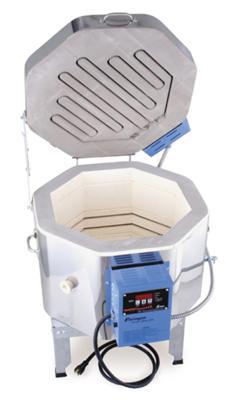I need your advice on the slumping process. I purchased a small rice bowl measuring 3 3/4 inches at its top, 2 3/4 inches at its side, and 2 1/2 inches at its base. I need to know how to figure the amount of surface glass (setting on top of the mold) I should cut in order to do a full fuse and slump.
Is there a formula for figuring these amounts? If a mold is rather deep must you add extra surface glass than that of one being shallow? Can I use the rice bowl for doing draping, too? If so, how would I determine the amount of surface glass needed? Will there be a tendency for unevenness at the base? If “yes”, is there a way I can possibly stop this from happening (I am wondering whether I can use fiber board, dams or a blanket.)?
Can you recommend a few good products that I can use for making my own fusible molds? I am wanting to make reusable ones that can be fused inside a kiln. I was given a bunch of white slip molds (I was intending to use them for casting.) but have been told they can’t be fired inside of a kiln?
Milly’s reply:
Lots of questions, thanks Cynthia. The first rule of the glass fusing/slumping work stream, is that you fuse flat first and then slump – or shape – the glass in a second firing. That way none of your fusing pieces fall off in the slumping process.
The size of the glass. This is determined by the circumferance of your mould. Put simply, the glass can’t be bigger than the mould, otherwise it will slump over the sides and you’ll have a lip and may have difficulty getting the glass off the mold.
The trajectory of the sides is important, yes, it’s easier to slump glass into a shallow mould, as there’s less chance of it deforming in the slumping process. If you have steep sides, you’ll need to adjust your kiln firing schedule to allow the glass time to slump slowly, rather than heating up quickly and sagging in the middle and not the sides.
I would recommend your fused glass to be a total of 6mm thick for glass slumping for your first projects – of course this can vary later, but any changes in the thickness of the glass needs more careful firing as it needs to anneal properly, so it’s best to start simple.
Yes, you can slump glass over moulds, but it will give you a ‘frilly’ edge. I haven’t found a way of avoiding this – professional glass makers will use cold working equipment (diamond saws and polishing tools etc) to cut and polish after firing. Lots of work! Some of my students loved the frilly look, so you could experiment.
You can make reusable glass slumping molds from clay, which is biscuit fired. Just make sure that you use a separator – eg batt wash – otherwise your glass will stick to the mold. Anything that can withstand heat of about 700-750C will be fine, but remember the separator.
Let me know how you get on.

